Ume_Group 1
Members: Im, JiHoo (Jihoo) / Baek, JooWon (Joowon) / Kim, DoYeon (Chloe) / Hwang, LaKyoung (Bell) / Lee, Arin (Irean) / Lee, YoonSeo (Emily)
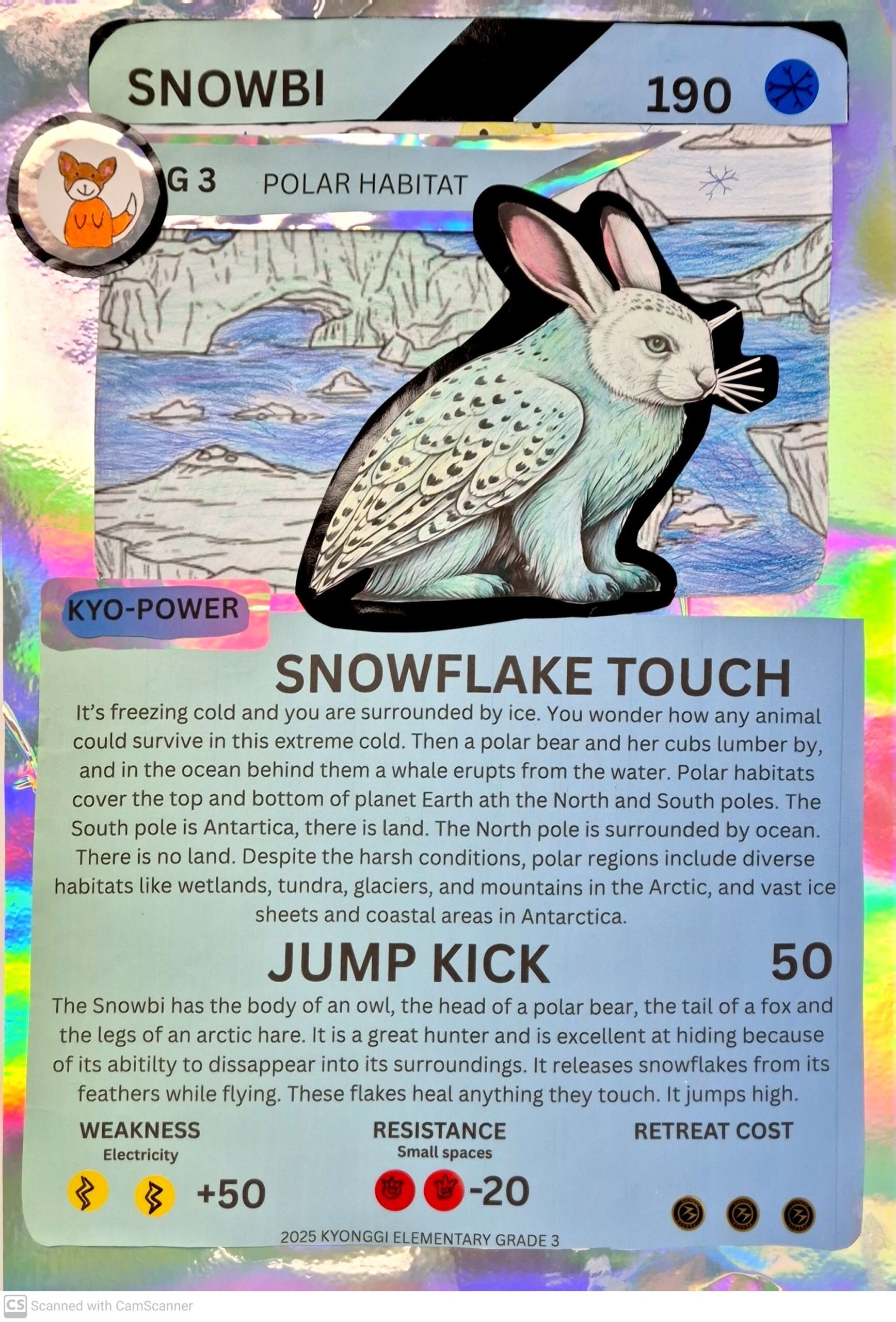
SNOWFLAKE TOUCH
It’s freezing cold, and you are surrounded by ice. You wonder how any animal could survive in this extreme cold. Then a polar bear and her cubs lumber by, and in the ocean behind them, a whale erupts from the water. Polar habitats cover the top and bottom of the planet Earth at the North and South poles. The South Pole is in Antarctica, and there is land. The North Pole is surrounded by the ocean. There is no land. Despite the harsh conditions, polar regions include diverse habitats like wetlands, tundra, glaciers, and mountains in the Arctic, and vast ice sheets and coastal areas in Antarctica.
JUMP KICK
The Snowbi has the body of an owl, the head of a polar bear, the tail of a fox, and the legs of an arctic hare. It is a great hunter and is excellent at hiding because of its ability to disappear into its surroundings. It releases snowflakes from its feathers while flying. These flakes heal anything they touch. It jumps high.
Ume_Group 2
Members: Kwon, TaeYun (Tom) / Park, ChulYoung (Leo) / Park, JaeEun (Jeni) / Lee, JuHa (Moana) / Ryoo, SeongJae (Jay) / Oh, SeungHeon (Hunny)
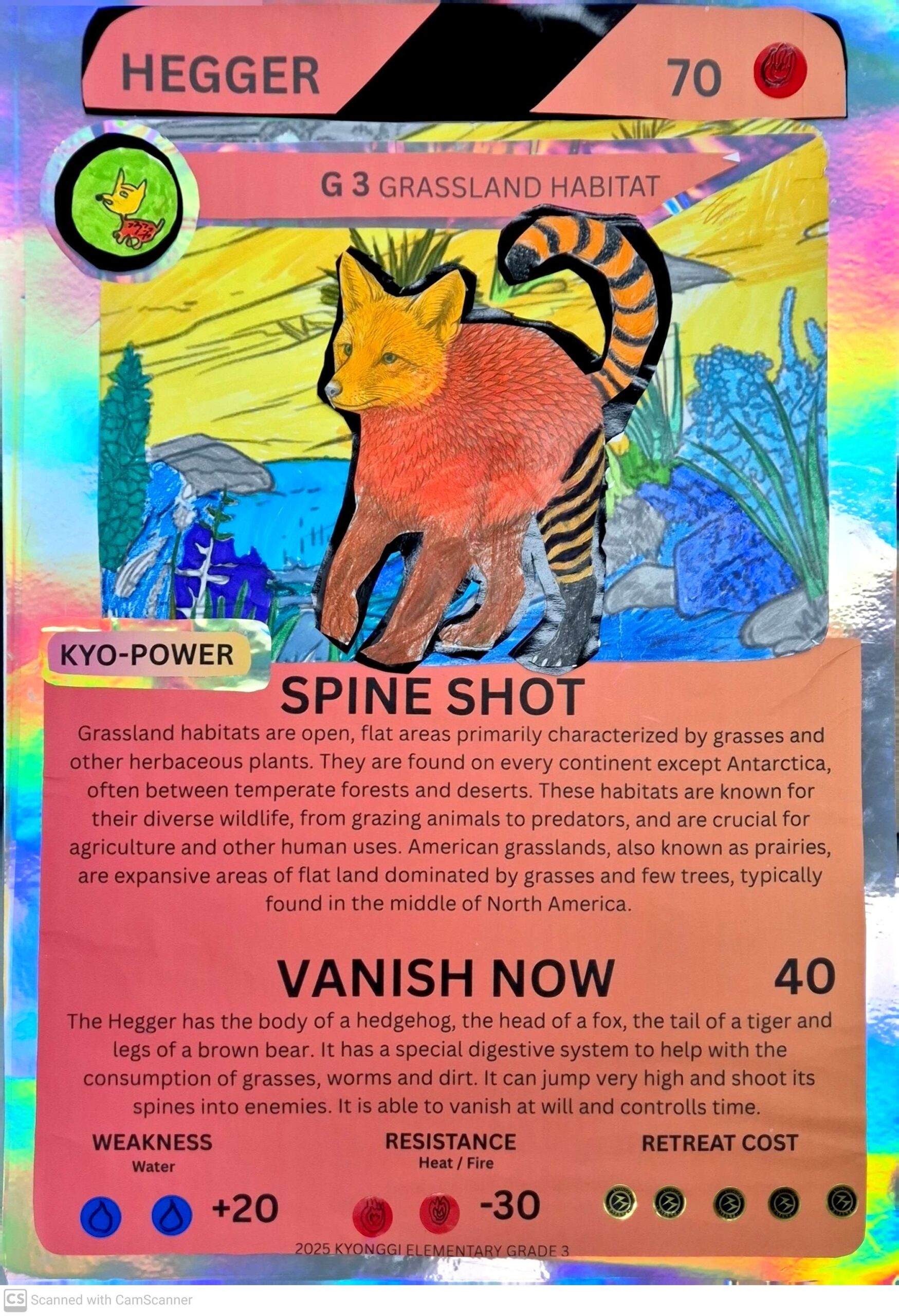
SPINE SHOT
Grassland habitats are open, flat areas primarily characterized by grasses and other herbaceous plants. They are found on every continent except Antarctica, often between temperate forests and deserts. These habitats are known for their diverse wildlife, from grazing animals to predators, and are crucial for agriculture and other human uses. American grasslands, also known as prairies, are expansive areas of flat land dominated by grasses and few trees, typically found in the middle of North America.
VANISH NOW
The Hegger has the body of a hedgehog, the head of a fox, the tail of a tiger, and the legs of a brown bear. It has a special digestive system to help with the consumption of grasses, worms, and dirt. It can jump very high and shoot its spines into enemies. It is able to vanish at will and controls time.
Ume_Group 3
Members: Yang, YooAhn (Yooahn) / Yang, SuhWoo (Kate) / Hwang, YunHo (Juno) / Han, HyeRin (Hyerin) / Ju, ChanYoung (Chanyoung) / Jung, SungYoon (Daniel)
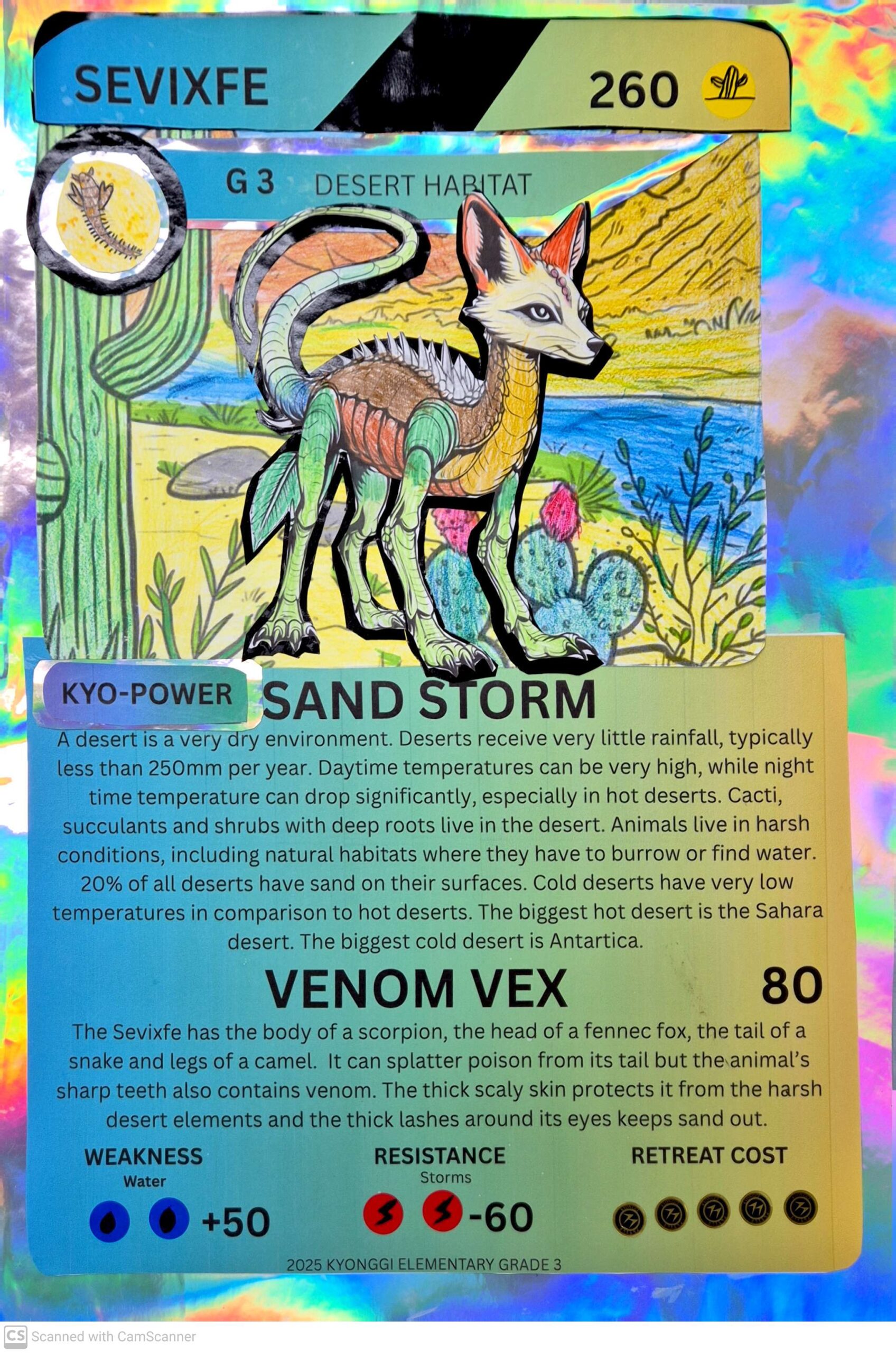
SAND STORM
A desert is a very dry environment. Deserts receive very little rainfall, typically less than 250mm per year. Daytime temperatures can be very high, while nighttime temperatures can drop significantly, especially in hot deserts. Cacti, succulents, and shrubs with deep roots live in the desert. Animals live in harsh conditions, including natural habitats where they have to burrow or find water. 20% of all deserts have sand on their surfaces. Cold deserts have very low temperatures in comparison to hot deserts. The biggest hot desert is the Sahara Desert. The biggest cold desert is Antarctica.
VENOM VEX
The Sevixfe has the body of a scorpion, the head of a fennec fox, the tail of a snake, and legs of a camel. It can splatter poison from its tail, but the animal’s sharp teeth also contain venom. The thick scaly skin protects it from the harsh desert elements,s and the thick lashes around its eyes keep sand out.
Ume_Group 4
Members: Kang, Ian (Ian) / Kim, DoYoon (Paul) / Kang, MinAh (Mina) / Lee, JiWon (Jenny) / Jeon, HaYeoung (Claire) / Kim, JuWon (Tony)
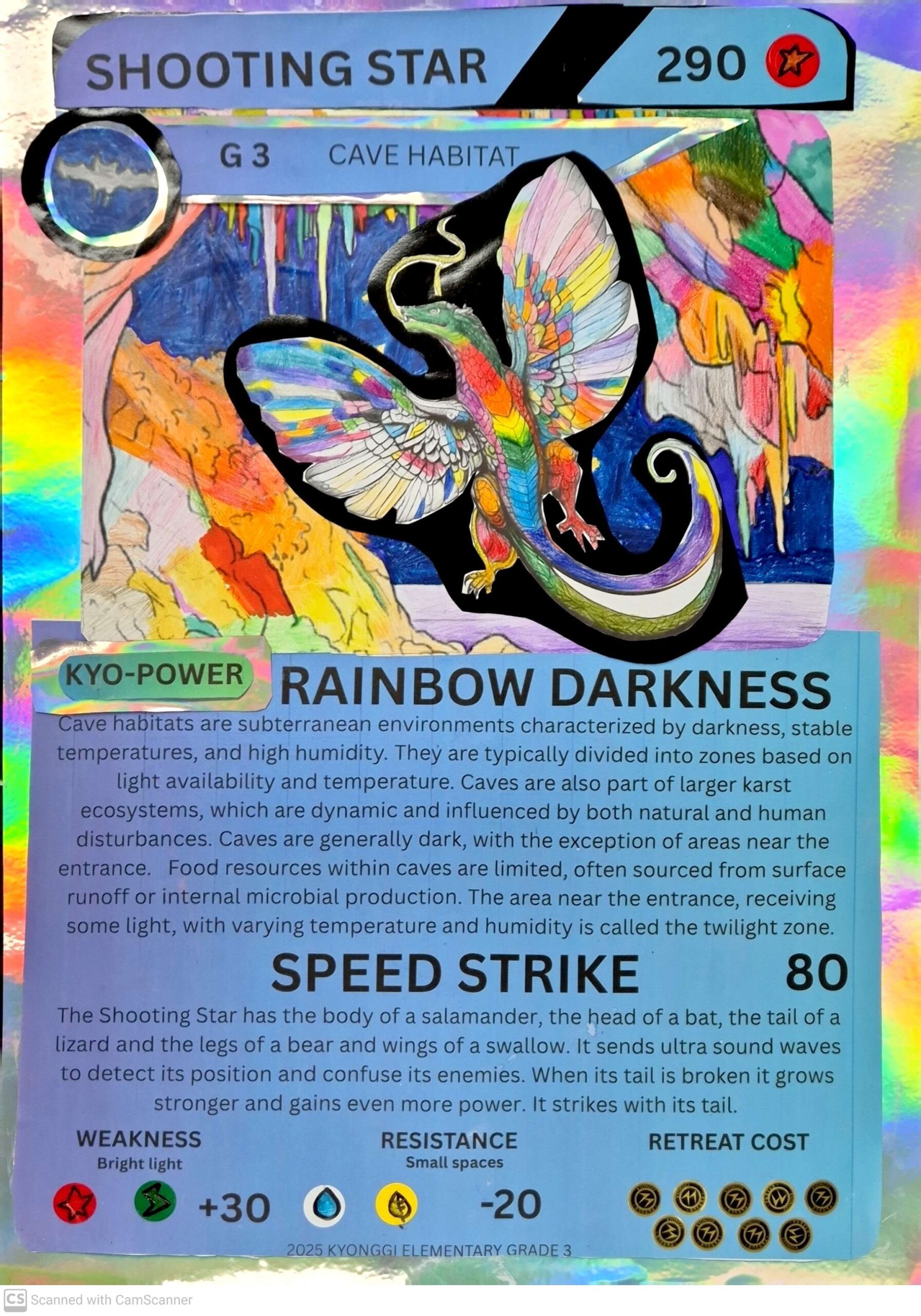
RAINBOW DARKNESS
Cave habitats are subterranean environments characterized by darkness, stable temperatures, and high humidity. They are typically divided into zones based on light availability and temperature. Caves are also part of larger karst ecosystems, which are dynamic and influenced by both natural and human disturbances. Caves are generally dark, with the exception of areas near the entrance. Food resources within caves are limited, often sourced from surface runoff or internal microbial production. The area near the entrance, receiving some light, with varying temperature and humidity, is called the twilight zone.
SPEED STRIKE
The Shooting Star has the body of a salamander, the head of a bat, the tail of a lizard, and the legs of a bear, and wings of a swallow. It sends ultrasonic waves to detect its position and confuse its enemies. When its tail is broken, it grows stronger and gains even more power. It strikes with its tail.
Rose_Group 1
Members: Suh, JuWon (Nathan) / Kang, Leo (Leo) / Roh, JuneBeom (JB) / Chae, MinGeon (Collin) / Kim, SeJin (Isabele) / Lee, YeoHyun (Yeohyun)
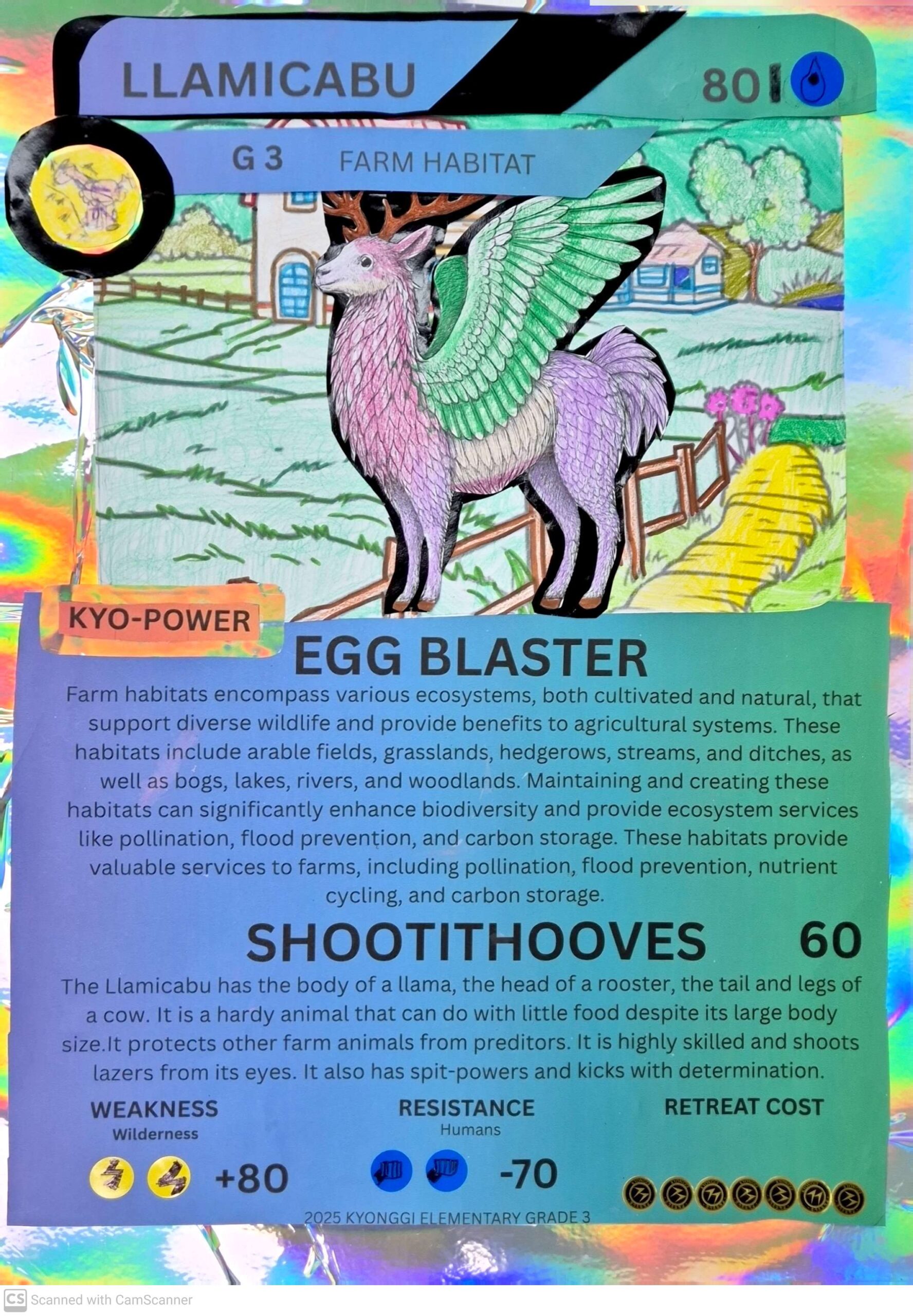
EGG BLASTER
Farm habitats encompass various ecosystems, both cultivated and natural, that support diverse wildlife and provide benefits to agricultural systems. These habitats include arable fields, grasslands, hedgerows, streams, and ditches, as well as bogs, lakes, rivers, and woodlands. Maintaining and creating these habitats can significantly enhance biodiversity and provide ecosystem services like pollination, flood prevention, and carbon storage. These habitats provide valuable services to humans and animals.
SHOOTITHOOVES
The Llamabu has the body of a llama, and the tail and legs of a cow. It is a hardy animal that can survive with little food despite its large body size. It protects other farm animals from predators. It is highly skilled and shoots lasers from its eyes. It also has spit-powers and kicks with determination.
Rose_Group2
Members: Kim, SeoYoung (Emily) / Kwon, JaeIn (Jaein) / Kang, Leo (Leo) / Kim, YeJun (June) / Cho, SeoYoung (Elly) / Hong, JuYeon (Jenny)
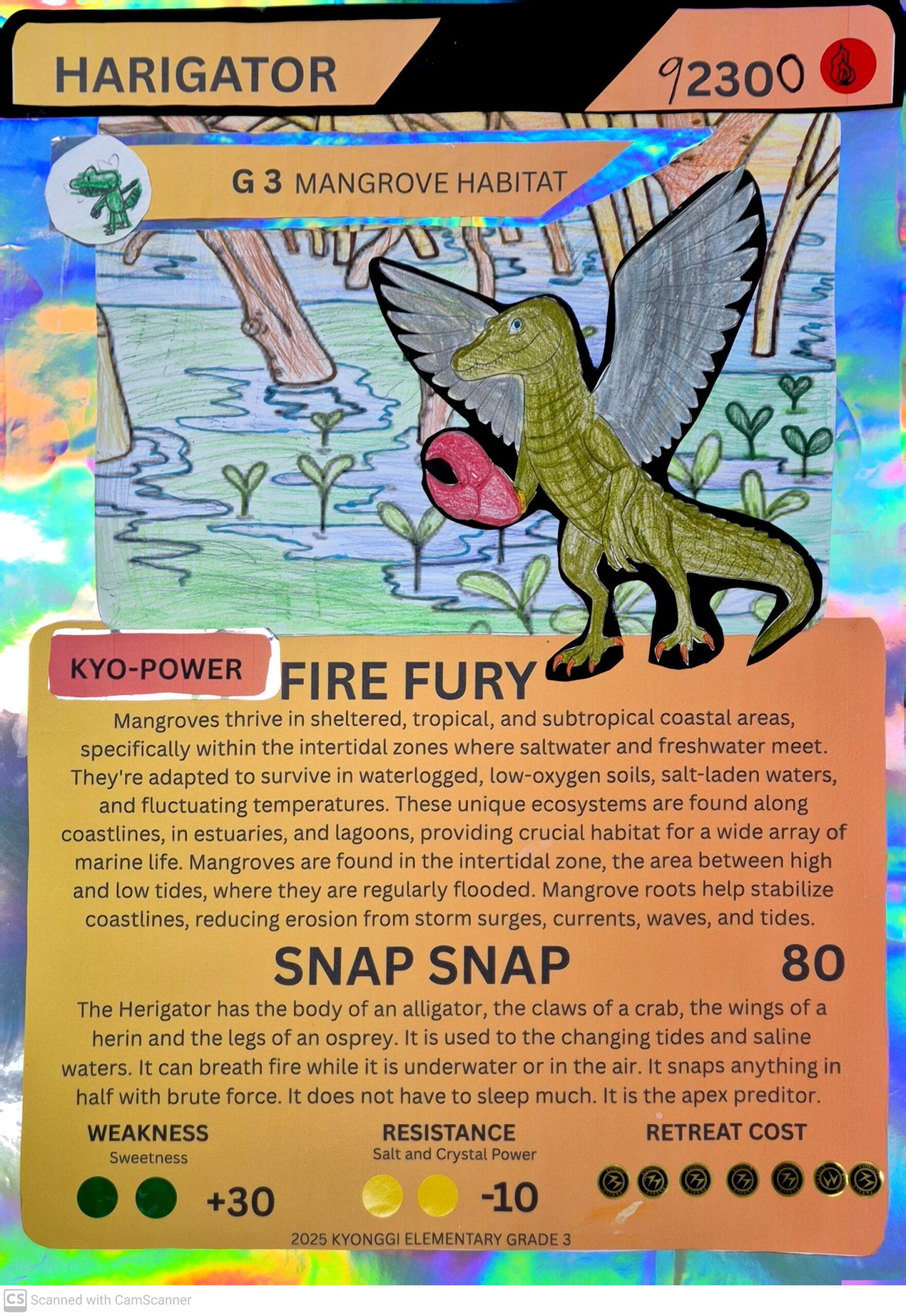
FIRE FURY
Mangroves thrive in sheltered, tropical, and subtropical coastal areas, specifically within the intertidal zones where saltwater and freshwater meet. They’re adapted to survive in waterlogged, low-oxygen soils, salt-laden waters, and fluctuating temperatures. These unique ecosystems are found along coastlines, in estuaries, and lagoons, providing crucial habitat for a wide array of marine life. Mangroves are found in the intertidal zone, the area between high and low tides, where they are regularly flooded. Mangrove roots help stabilize coastlines, reducing erosion from storm surges, currents, waves, and tides.
SNAP SNAP
The Herigator has the body of an alligator, the claws of a crab, the wings of a heron, and the legs of an osprey. It is adapted to the changing tides and saline waters. It can breathe fire while it is underwater or in the air. It snaps anything in half with brute force. It does not have to sleep much. It is the apex predator.
Rose_Group3
Members: Kang, YiJin (Anna) / Ihm, RyeoWon (Caitlin) / Kim, JaeAh (Jaeah) / Lee, SunWoo (Olivia) / Cho, YeoJoon (Yeojoon) / Tak, SeoWoo (Chris)
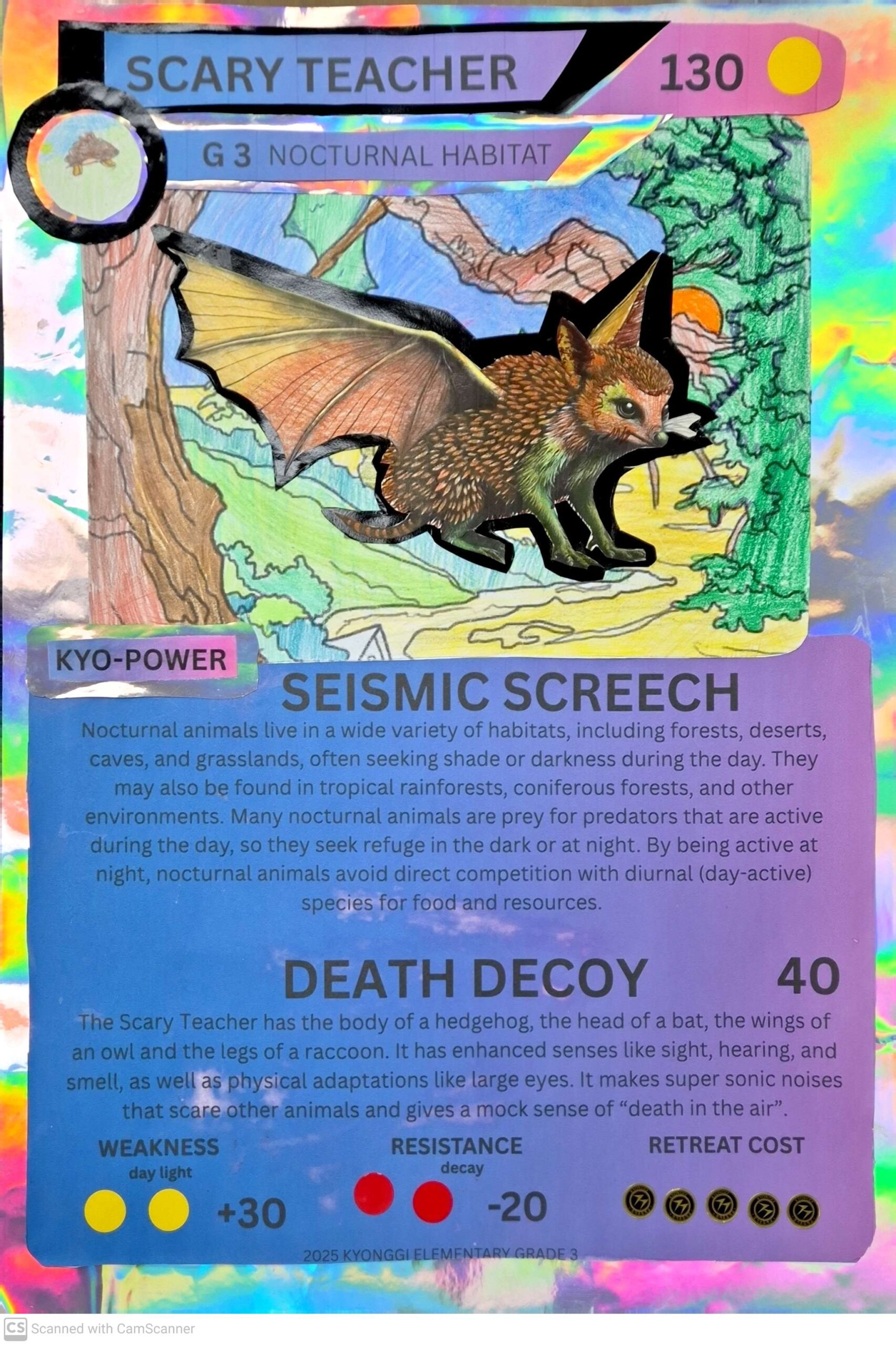
SEISMIC SCREECH
Nocturnal animals live in a wide variety of habitats, including forests, deserts, caves, and grasslands, often seeking shade or darkness during the day. They may also be found in tropical rainforests, coniferous forests, and other environments. Many nocturnal animals are prey for predators that are active during the day, so they seek refuge in the dark or at night. By being active at night, nocturnal animals avoid direct competition with diurnal (day-active) species for food and resources.
DEATH DECOY
The Scary Teacher has the body of a hedgehog, the head of a bat, the wings of an owl, and the legs of a raccoon. It has enhanced senses like sight, hearing, and smell, as well as physical adaptations like large eyes. It makes supersonic noises that scare other animals and gives a mock sense of “death in the air”.
Rose_Group4
Members: Kim, YeonHo (William) / Seo, Ihyun (Elin) / Lee, MinJae (Minjae) / Lee, JiWoo (Alice) / Back, JiHu (Jack) / Yu, HyeonSeo (Lucas)
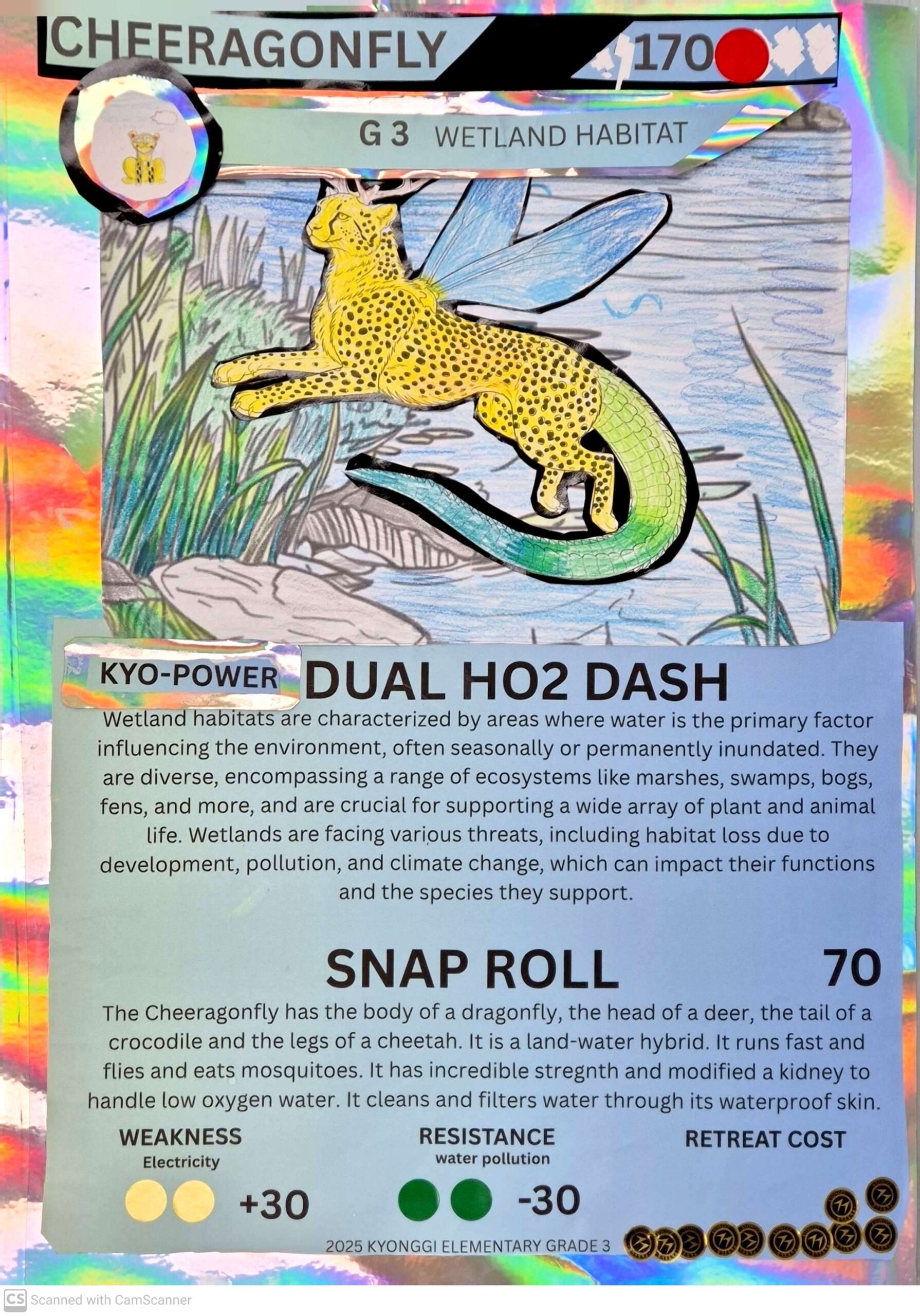
DUAL HO2 DASH
Wetland habitats are characterized by areas where water is the primary factor influencing the environment, often seasonally or permanently inundated. They are diverse, encompassing a range of ecosystems like marshes, swamps, bogs, fens, and more, and are crucial for supporting a wide array of plant and animal life. Wetlands are facing various threats, including habitat loss due to development, pollution, and climate change, which can impact their functions and the species they support.
SNAP ROLL
The Cheeragonfly has the body of a dragonfly, the head of a deer, the tail of a crocodile, and the legs of a cheetah. It is a land-water hybrid. It runs fast, flies, and eats mosquitoes. It has incredible strength and has modified kidneys to handle low-oxygen water. It cleans and filters water through the top layer of its waterproof skin.
Orchid_Group1
Members: Cha, HyoWoo (Ella) / Oh, SooHyun (Hailey) / Kim, YuJung (Alex) / Lee, YoungVin (Vincent) / Lee, JuYoung (Daniel) / Han, Inje (Inje)

FIFIFLOW-FLASH
Ponds are small, shallow freshwater ecosystems that are home to many plants and animals. They provide essential resources like water, food, and shelter for many species, making them vital habitats for diverse ecosystems. Ponds can be natural or man-made and are home to various aquatic and semi-aquatic organisms. Ponds support a wide array of organisms, including fish, amphibians, invertebrates, and various plants. Ponds play a significant role in maintaining biodiversity and can be important for mitigating the impacts of human activities on aquatic ecosystems.
HYDRO HIT
The Fifiwimid has the body of a fish, the head of a frog, the wings of a dragonfly, and the legs of a duck. It is able to swim in the water, paddle above it, and fly over it. It can see well, and can adapt to different climates. Its body acts as a shield, and it can spew water from its mouth with great pressure. It is resilient.
Orchid_Group2
Members: Kwon, SaRang (Sophia) / Lee, SoYoon (Elena) / Ko, DaYeon (Rose) / Kim, DaEun (Ellie) / Park, SuEun (Leo) / Ahn, DoYeon (Doyeon)

POLLIN PUFF
A garden can be a diverse habitat, supporting various plants and animals. Different areas within a garden, like lawns, borders, trees, ponds, and woodpiles, each offer unique habitats for specific creatures. By understanding these diverse areas, gardeners can create a more wildlife-friendly space. Hedges, flowerbeds, and walls offer nectar and seed sources for bees, butterflies, birds, and small animals. Ponds offer water for birds and other animals, and provide habitats for amphibians and aquatic invertebrates.
POWER FLOW
The Orcute has the body of a squirrel, the head of a rabbit, the wings of a butterfly and the legs of an ant. It can fly from flower to flower to help with pollination, it stores food for winter, and lives in tree hollows. Its main attribute is that it can blend in with its environment. It also has a pollen attack.
Orchid_Group3
Members: Kim, Aine (Aine) / Kuk, SoHeon (Grace) / Kim, DoHyeon (Sam) / Kim, SooAn (Shawn) / Lee, WonWoo (Winny) / Lee, SiHyung (Jenny)
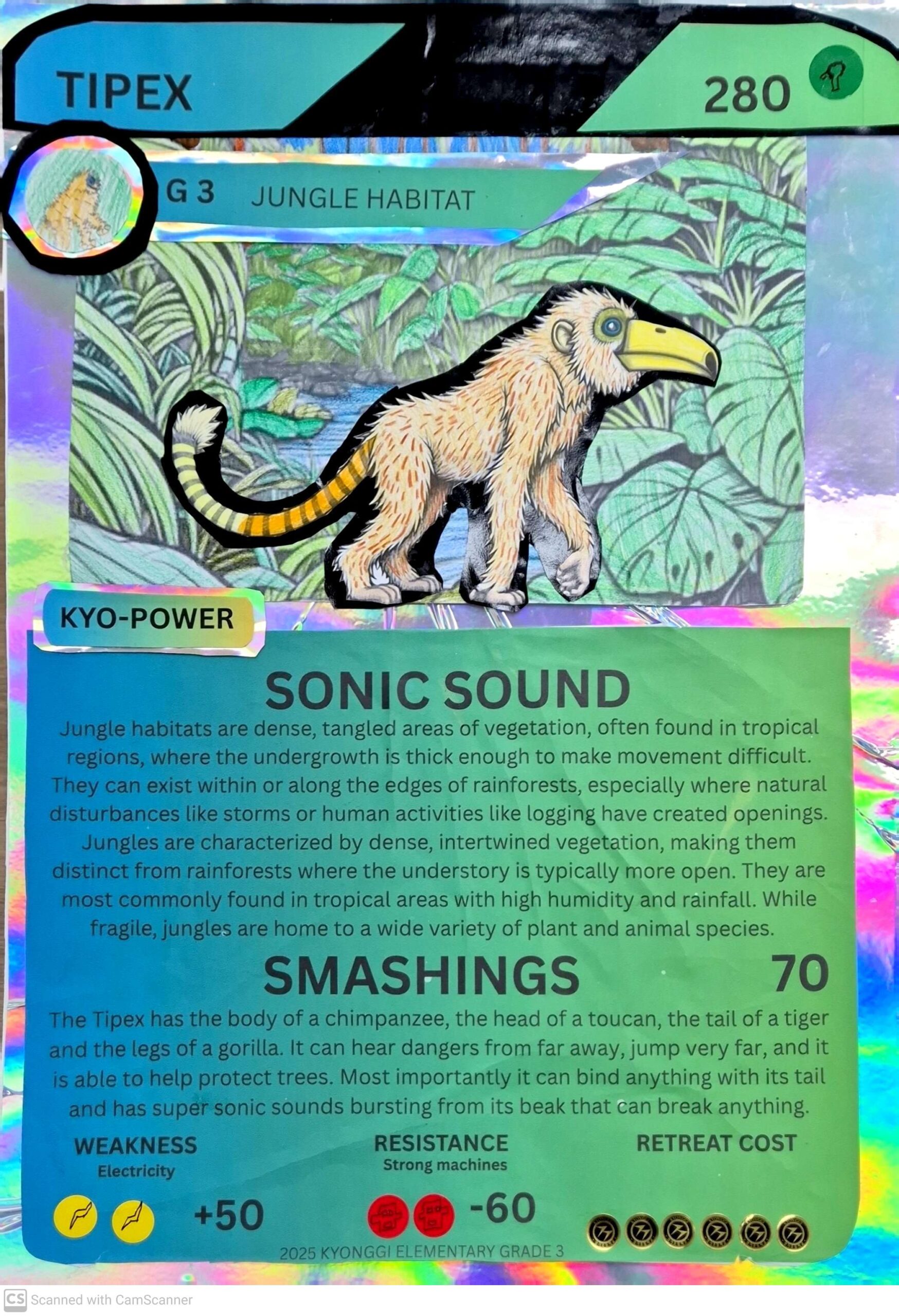
SONIC SOUND
Jungle habitats are dense, tangled areas of vegetation, often found in tropical regions, where the undergrowth is thick enough to make movement difficult. They can exist within or along the edges of rainforests, especially where natural disturbances like storms or human activities like logging have created openings. Jungles are characterized by dense, intertwined vegetation, making them distinct from rainforests, where the understory is typically more open. They are most commonly found in tropical areas with high humidity and rainfall. While fragile, jungles are home to a wide variety of plant and animal species.
SMASHINGS
The Tipex has the body of a chimpanzee, the head of a toucan, the tail of a tiger, and the legs of a gorilla. It can hear dangers from far away, jump very far, and it is able to help protect trees. Most importantly, it can blind anything with its tail and has supersonic sounds bursting from its beak that can break anything.
Orchid_Group4
Members: Yim, JuWon (Sophia) / Yoon, JunSuh (Junsuh) / Bea, HanNa (Hanna) / Ahn, SeoYoon (Lena) / Kim, BeomSeok (Beomseok) / Ahn, HwiKyung (Lucas)
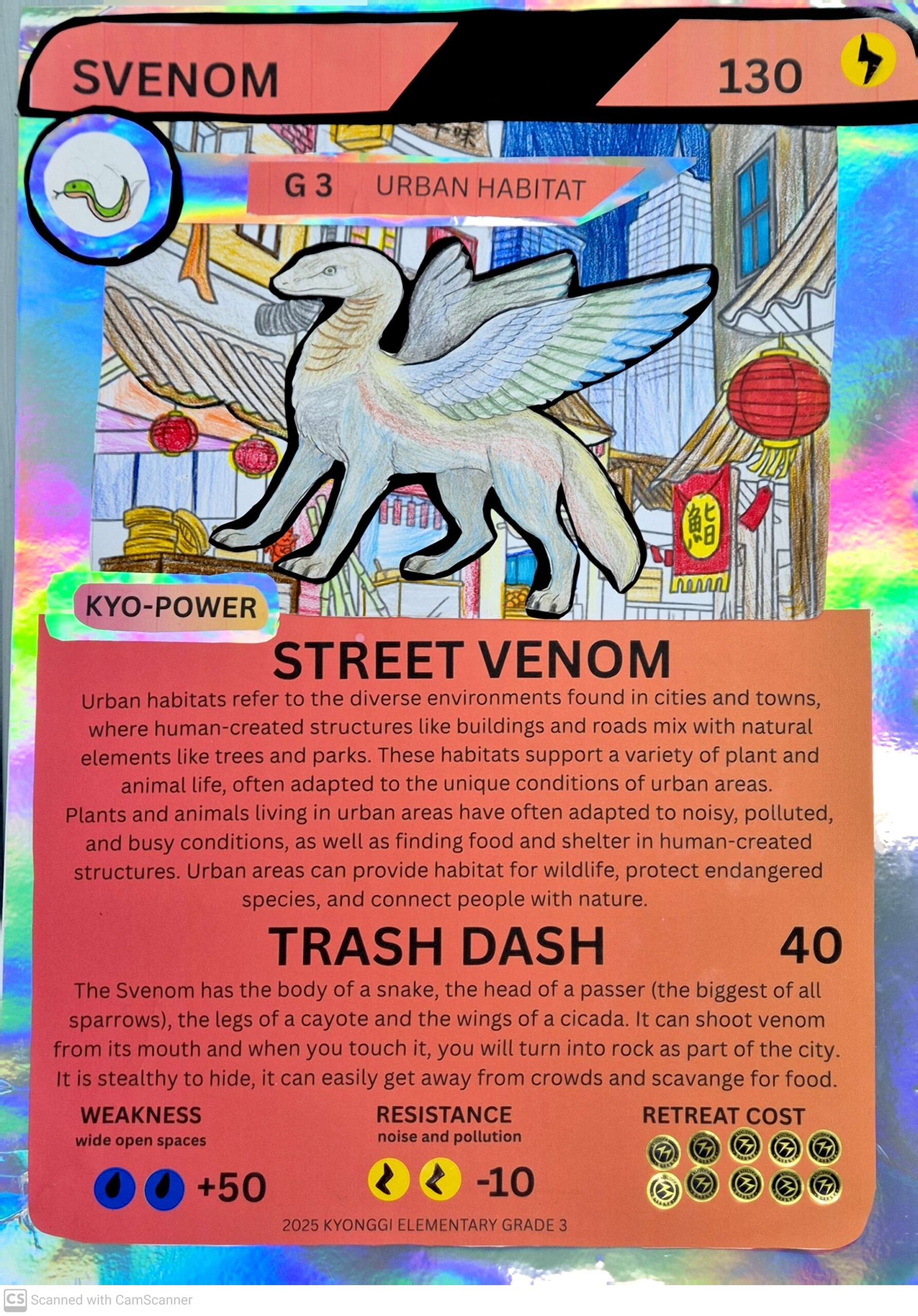
STREET VENOM
Urban habitats refer to the diverse environments found in cities and towns, where human-created structures like buildings and roads mix with natural elements like trees and parks. These habitats support a variety of plant and animal life, often adapted to the unique conditions of urban areas.
Plants and animals living in urban areas have often adapted to noisy, polluted, and busy conditions, as well as finding food and shelter in human-created structures. Urban areas can provide habitat for wildlife, protect endangered species, and connect people with nature.
TRASH DASH
The Svenom has the body of a snake, the head of a passer (the biggest of all sparrows), the legs of a coyote, and the wings of a cicada. It can shoot venom from its mouth, and when you touch it, you will turn into rock as part of the city. It is stealthy, so it can easily get away from crowds and scavenge for food.
Peony_Group1
Members: Yoo, JiHoo (Jihoo) / Song, YooNa (Clara) / Park, ChaeYoon (Aurora) / Lee, SiOn (Sion) / Yoon, JaeWon (Mars) / Park, HaNel (Sky)
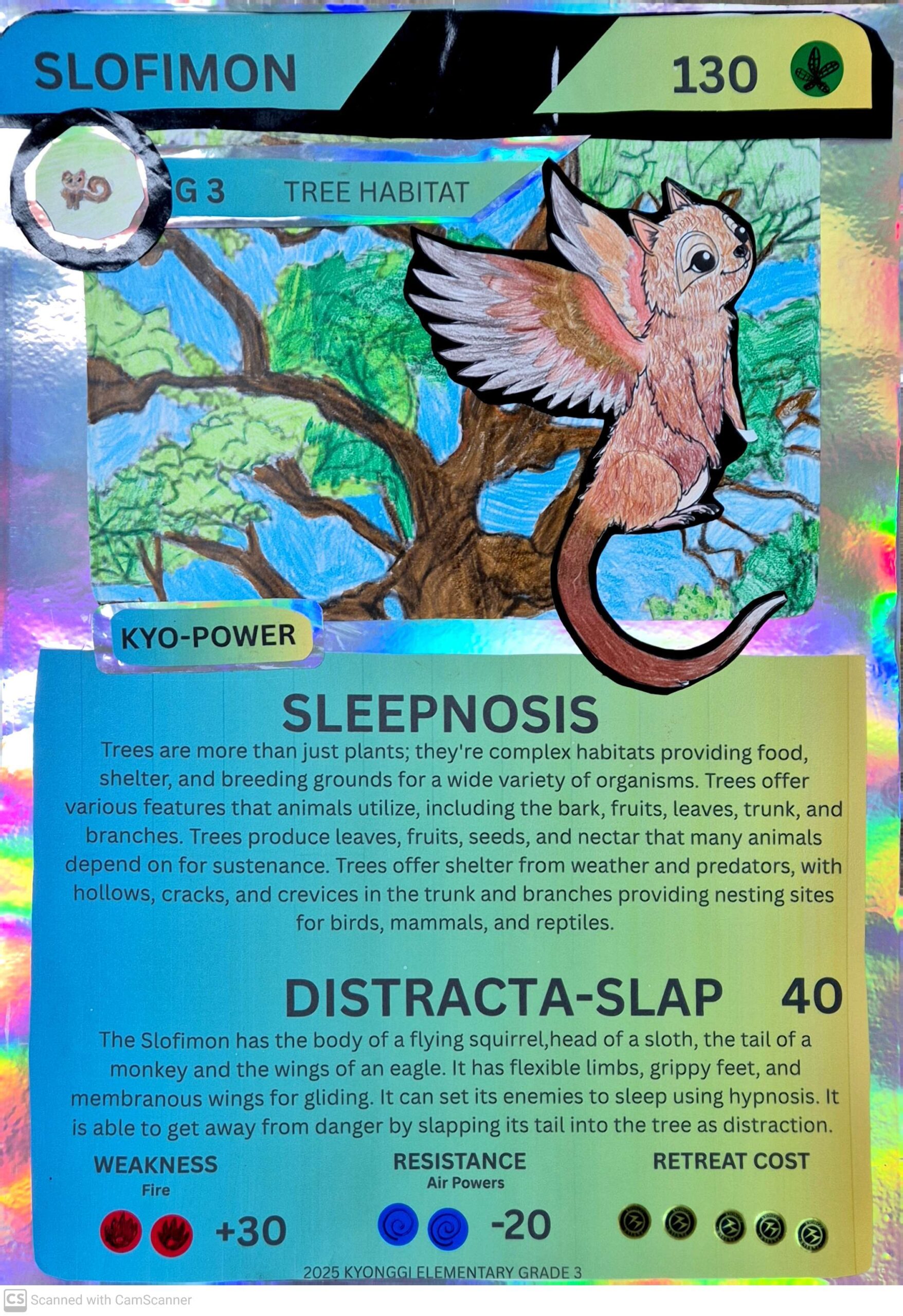
SLEEPNOSIS
Trees are more than just plants; they’re complex habitats providing food, shelter, and breeding grounds for a wide variety of organisms. Trees offer various features that animals utilize, including the bark, fruits, leaves, trunk, and branches. Trees produce leaves, fruits, seeds, and nectar that many animals depend on for sustenance. Trees offer shelter from weather and predators, with hollows, cracks, and crevices in the trunk and branches providing nesting sites for birds, mammals, and reptiles.
DISTRACTA-SLAP
The Slofimon has the body of a flying squirrel, the head of a sloth, the tail of a monkey, and the wings of an eagle. It has flexible limbs, grippy feet, and membranous wings for gliding. It can set its enemies to sleep using hypnosis. It is able to get away from danger by slapping its tail into the tree as a distraction.
Peony_Group2
Members: Kim, Yoon (Yoon) / Kim, DohYoon (Daniel) / Kim, JunKyeong (Junkyeong) / Son, ChaeEun (Sophie) / Na, HyunSeo (Judy) / Park, SeOne (Jenna)
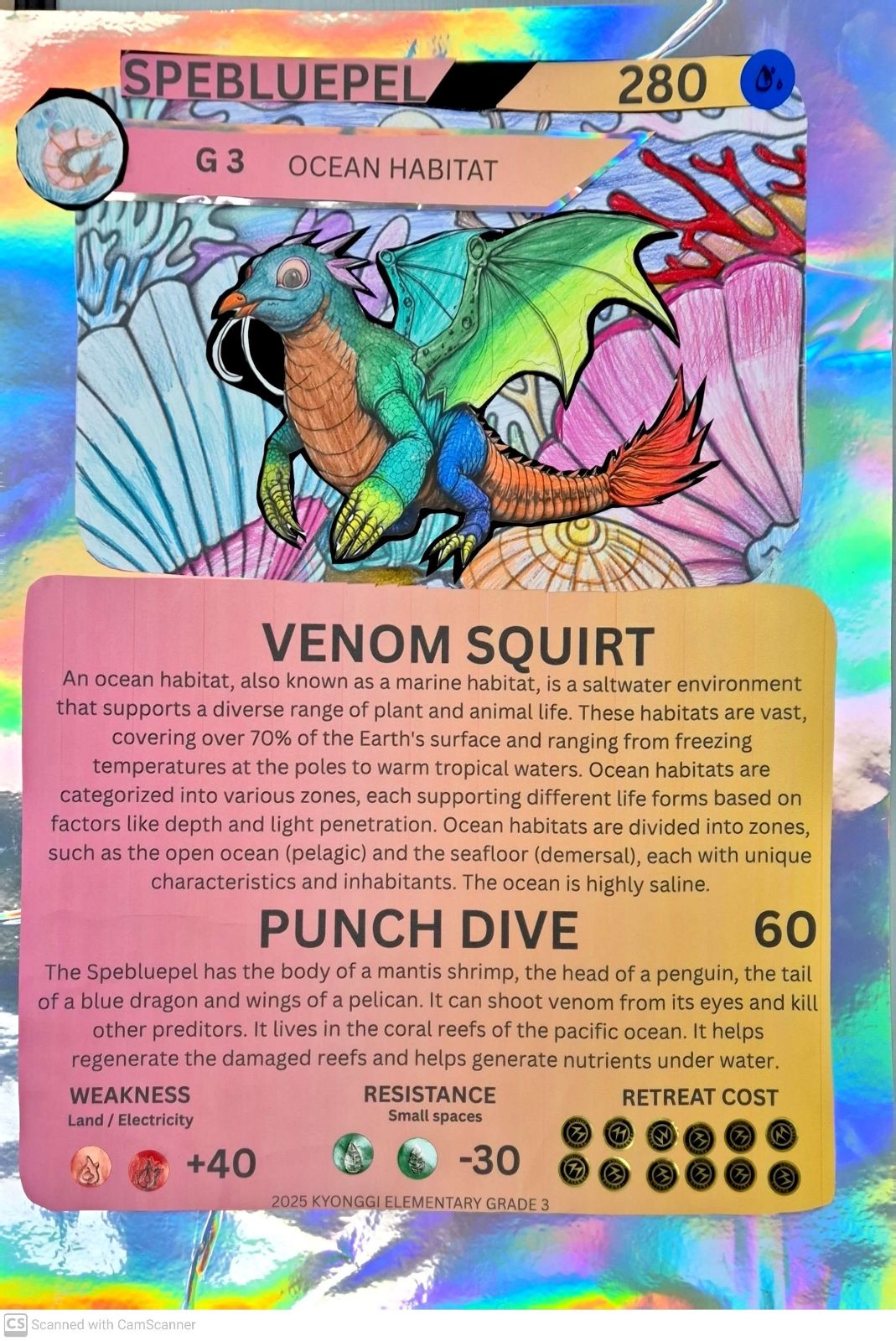
VENOM SQUIRT
An ocean habitat, also known as a marine habitat, is a saltwater environment that supports a diverse range of plant and animal life. These habitats are vast, covering over 70% of the Earth’s surface and ranging from freezing temperatures at the poles to warm tropical waters. Ocean habitats are categorized into various zones, each supporting different life forms based on factors like depth and light penetration. Each zone, such as the open ocean (pelagic) and the seafloor (demersal), each with unique characteristics and inhabitants. The ocean is highly saline.
PUNCH DIVE
The Spebluepel has the body of a mantis shrimp, the head of a penguin, the tail of a blue dragon, and wings of a pelican. It can shoot venom from its eyes and kill other predators. It lives in the coral reefs of the Pacific Ocean. It helps regenerate the damaged reefs and helps generate nutrients underwater.
Peony_Group3
Members: Son, JiHwan (Daniel) / Ko, WooJin (Woojin) / Cheon, JiYu (Jiyu) / Lee, KyungWon (Rex) / Kang, SiWan (Noah) / Han, JunMin (Joon)
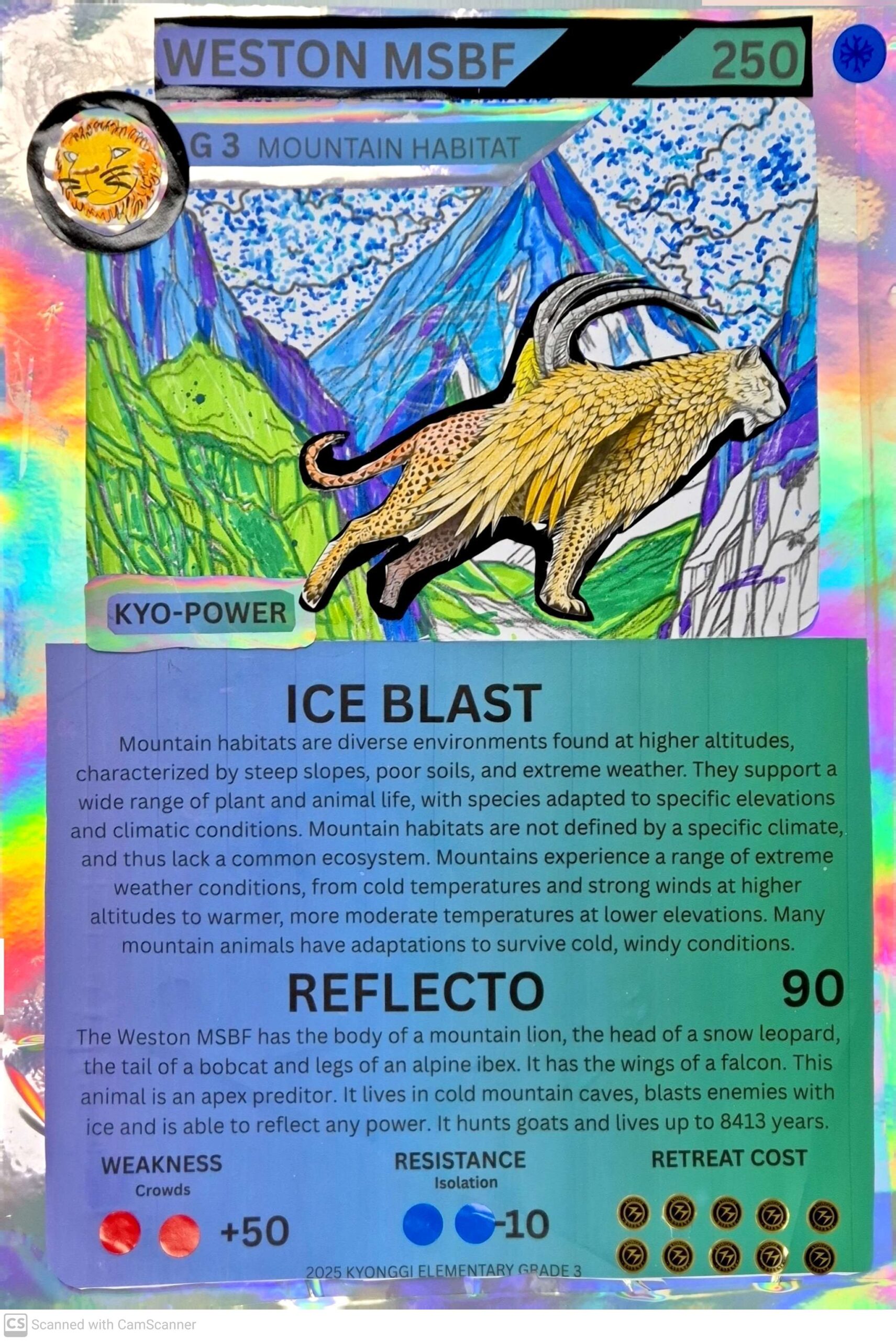
ICE BLAST
Mountain habitats are diverse environments found at higher altitudes, characterized by steep slopes, poor soils, and extreme weather. They support a wide range of plant and animal life, with species adapted to specific elevations and climatic conditions. Mountain habitats are not defined by a specific climate, and thus lack a common ecosystem. Mountains experience a range of extreme weather conditions, from cold temperatures and strong winds at higher altitudes to warmer, more moderate temperatures at lower elevations. Many mountain animals have adaptations to survive cold, windy conditions.
REFLECTO
The Weston MSBF has the body of a mountain lion, the head of a snow leopard, the tail of a bobcat, and legs of an alpine ibex. It also has the wings of a falcon. This animal is an apex predator. It lives in cold mountain caves, blasts enemies with ice, and is able to reflect any power. It hunts goats and lives up to 8413 years.
Peony_Group 4
Members: Jeong, YeonWoo (Olivia) / Kim, SeoYoon (Grace) / Kim, BanYa (Banya) / Lee, LoHa (Loha) / Kim, YeJun (Mcqueen) / Kim, YooChan (Yoochan)
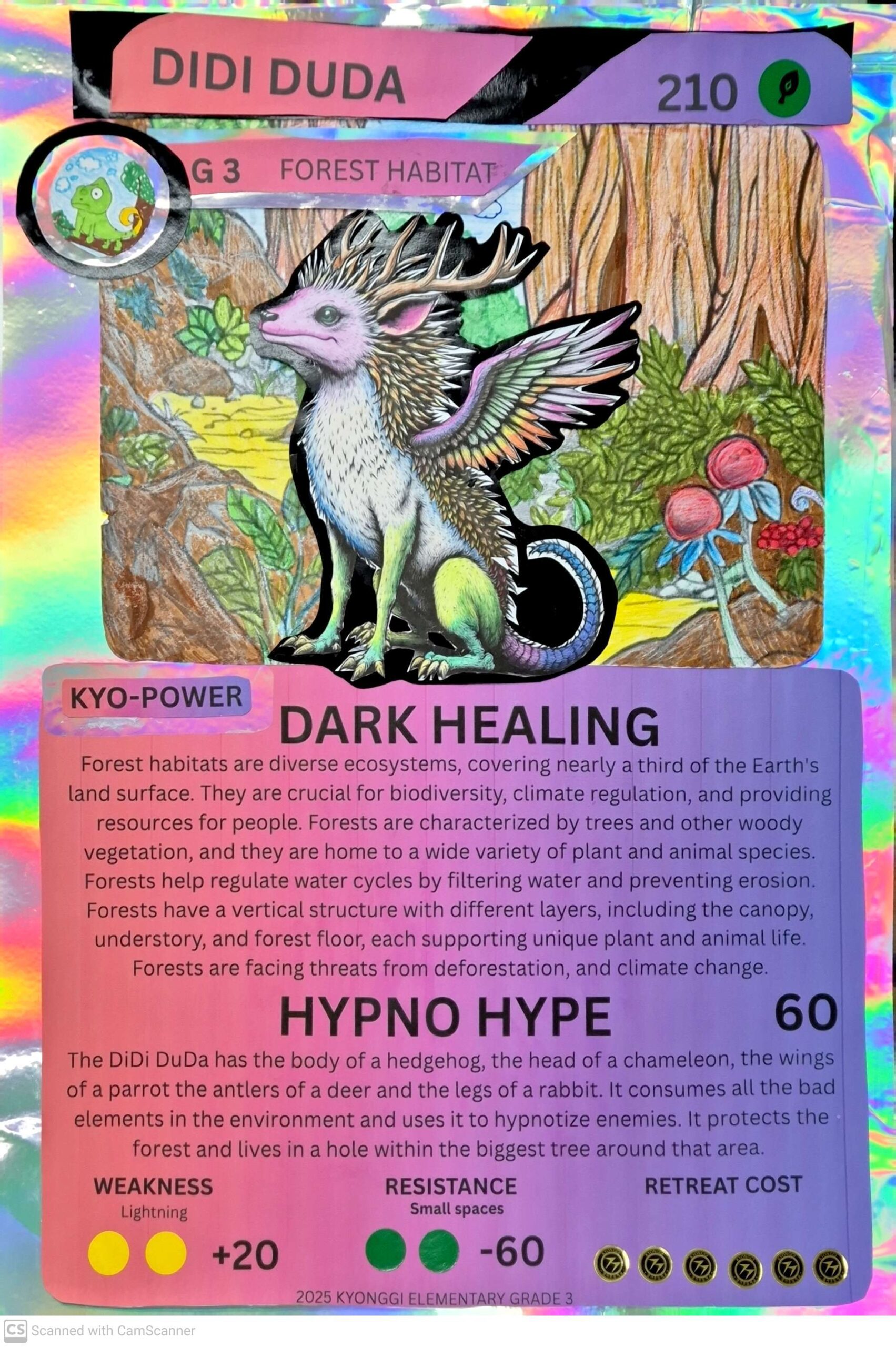
DARK HEALING
Forest habitats are diverse ecosystems, covering nearly a third of the Earth’s land surface. They are crucial for biodiversity, climate regulation, and providing resources for people. Forests are characterized by trees and other woody vegetation, and they are home to a wide variety of plant and animal species. Forests help regulate water cycles by filtering water and preventing erosion. Forests have a vertical structure with different layers, including the canopy, understory, and forest floor, each supporting unique plant and animal life. Forests are facing threats from deforestation and climate change.
HYPNO HYPE
The DiDi DuDa has the body of a hedgehog, the head of a chameleon, the wings of a parrot, the antlers of a deer, and the legs of a rabbit. It consumes all the bad elements in the environment and uses them to hypnotize enemies. It protects the forest and lives in a hole within the biggest tree around that area.
